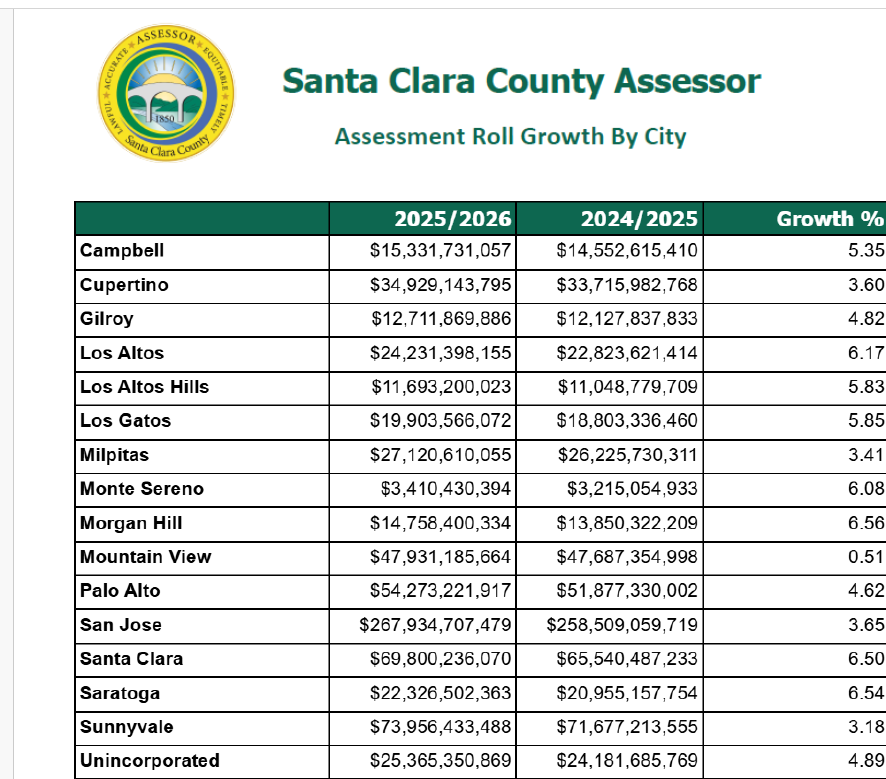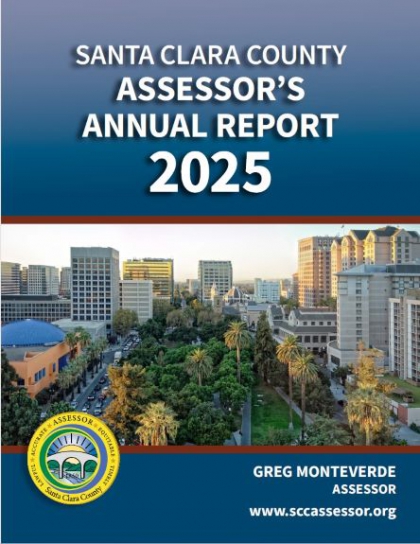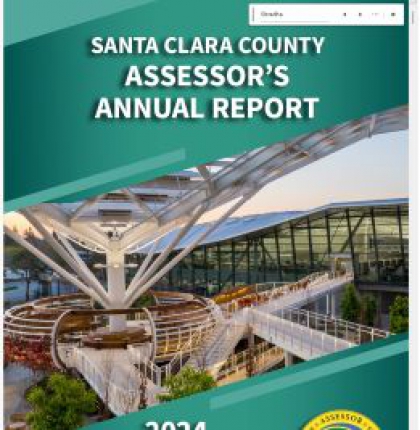
Every year we work to continuously improve the report and if you have suggestions please do not hesitate to let our office know.
Every year we work to continuously improve the report and if you have suggestions please do not hesitate to let our office know.
2025 Assessment Roll Growth at $28.9 billion, led by assessments of residential transfers of ownership and inflation factor
Santa Clara County, California, July 2, 2025 – This year’s annual assessment roll increased by 4.15 percent, marking the lowest growth since 2012. The stagnation was largely due to ongoing challenges in the commercial real estate market. In contrast, residential property transfer of ownership transactions increased by 3 percent and accounted for 86 percent of roll growth.
The 2025-2026 assessment roll is comprised of the total net assessed value of all real and business and personal property in Santa Clara County as of the January 1, 2025 lien date, and reflects changes between January 1 and December 31, 2024. The total of this year’s roll reached a new height of $725.7 billion.
The leading contributors to the increase in roll growth are changes in ownership, application of the Prop. 13 two percent annual inflation factor, and new construction, accounting for $16.1 billion, $14.4 billion and $3.8 billion, respectively. Business Property values added $1.8 billion and roll corrections added $1 billion. However, these increases were offset by a $2.3 billion increase in exemptions, $2.6 billion in Prop. 8 reductions, and roll correction reductions of $2.4 billion.
Changes in property ownership accounted for 56 percent of this year’s increase in the assessed value. Residential property transfers consisted of 86 percent of the value. The number of residential transactions has been on the decline for the last couple of years, with a small rebound of 3 percent growth this year. Commercial transaction volume increased 6 percent and sales prices have been consistently lower than assessed value, removing value from the roll.
Proposition 13 limits the assessment of properties without new activity or transactions to the California Consumer Price Index (CCPI) or two percent, whichever is lower. This component added $14.4 billion to the 2025-2026 assessment roll. “Even when real estate values are soaring, Proposition 13 limits the increase in assessment to two percent, a significant financial benefit to most property owners, especially over time,” said County Assessor Larry Stone.
“As Assessor, my responsibility is to ensure that accurate values are enrolled based upon market conditions. When market value (as of January 1, 2025) falls below the existing assessment, my office is required by law to temporarily reduce the assessed value to reflect the declining market value. Each year, my office proactively reviews the value of all residential property in the County to determine the accurate assessment. When property owners receive their Notification of Assessed Value (NAV) card in the mail or electronically, they have an opportunity to review their assessed value and compare it to the market data we use to make the assessment. If they believe their property meets the criteria for a Prop. 8 reduction, they can apply for an informal review,” said Stone.
This year’s roll includes 8,699 properties in decline status, a decline from 11,226 in the prior roll year. While residential reductions declined by count and value, commercial reductions increased by count (31 percent) and value (181 percent). Commercial reductions reduced the roll by over $4.5 billion.
Increasing vacancies, declining rental rates, the absence of big leasing deals, and the continuation of hybrid and remote working, have kept the office vacancy rate in Silicon Valley at roughly 20 percent for the past two years.
An increasing number of office buildings are selling for less than assessed value and foreclosures from delinquent loans are becoming more frequent. “Ninety-eight percent of the $145 billion of assessed value under appeal is commercial property. We expect to receive a greater number of commercial property assessment appeals filed this year, which may result in assessment roll corrections reducing the value of the assessment roll,” said Stone.
When an assessment appeal is filed, the County must reserve against the value at risk, further reducing available funds for essential government services.
New construction is a core component of assessment growth. Unfortunately, at $3.8 billion, it accounted for 34 percent less growth than the prior year. Commercial development, with the exception of multi-family housing, has been severely curtailed, especially the office market.
Several significant commercial development projects have stalled due to various factors, including high interest rates, rising construction costs, and a decreased demand for office space. Google’s “Downtown West” project in San Jose was approved by the city council and slated to begin in 2023, but remains in limbo to date. And “The Rise” at the former Vallco Mall in Cupertino, a massive mixed-use development, requires redesign and cutbacks before it can proceed. And “Related Santa Clara,” a proposed 240 acre mixed use development, also faces redesign before the start of construction.
The near-term impact of reduced property sales and values, as well as changes in stalled construction plans, are likely to result in reduced assessment roll growth in the years ahead.
However, the long-term outlook for the region is good. With 80 percent of all tech R&D occurring in Silicon Valley and the headquarters of three trillion-dollar companies – Apple, Microsoft, and NVIDIA – the global attraction of the region will not change anytime soon. In fact, both Apple and Nvidia have continued to invest in Santa Clara County respectively acquiring large parcels of real estate.
The assessment of “business and personal property,” i.e. machinery, equipment, computers, and fixtures, recorded an increase of 2.2 percent to $50.5 billion. Santa Clara County historically has the second-largest business property values in California.
Though the majority of homeowners enjoy relatively low assessments compared to the market value of their properties due to Prop. 13, it comes at a cost to schools and local governments dependent on the revenue necessary to fund quality education and public services.
The 2025-2026 assessment roll is a snapshot of property values as of January 1, 2025. “While residential property values have stabilized recently, high mortgage interest rates and tariff-generated inflation have reduced consumer buying power. With office vacancy increasing due in part to remote work, and the residential sales decreasing, the volatile and unpredictable nature of Santa Clara County real estate causes concern for the future of property values,” said Stone.
Leadership Transition
After 30 years as Assessor and more than 47 years in dedicated public service, Lawrence E. “Larry” Stone, the elected Assessor of Santa Clara County, has announced that he will will officially step down on July 6, 2025. “I am deeply proud to have led the Santa Clara County Assessor’s office for the past three decades,” said Stone. Effective July 7, 2025, Greg Monteverde will become Acting Assessor and maintain the same commitment to customer service. Neysa Fligor will assume the duties of Assistant Assessor.
Beneficiaries of property tax revenue
The major beneficiaries of property tax revenue are public schools, community colleges, cities, special districts, and Santa Clara County. Fifty percent of local property tax revenue generated in Santa Clara County goes to fund public education. To find out more about property tax, visit the “Property Tax Story” on the County data pages.
Annual Notification of Assessed Value (NAV)
On June 30, the Assessor’s Office sent annual Notification of Assessed Value (NAV) Cards to 499,033 properties, reporting each property’s 2025 assessed value. The notice serves as the basis for the property tax bill. Santa Clara County is one of only 11 counties in California that provides early assessment notice to property owners. “Most property owners in California learn of their assessed value for the first time when they receive their property tax bill in October,” said Stone.
Requesting a Temporary Reduction in Assessed Value
Property owners who can demonstrate their assessment is higher than the market value of their property (as of January 1, 2025) are encouraged to request an informal review of their assessment no later than August 1. “My appraisal staff will complete as many informal reviews as possible before August 15, the deadline for making adjustments that will be reflected on the property tax bill mailed in the fall,” said Stone. To apply for a reduction, go to www.sccassessor.org/prop8.
Assessment Appeals
The annual notice also describes the process for filing a formal assessment appeal by the September 15, 2025 deadline. Residential property owners who decide to file a formal appeal, are encouraged to request their appeal be adjudicated by an independent residential Value Hearing Officer (VHO). VHO hearings are scheduled frequently, allowing for a more rapid resolution.
“Property owners who disagree with the assessed value should not wait for the tax bill before filing an appeal, as the tax bill is mailed by the Tax Collector after the assessment appeal filing deadline,” said Stone. More information is available from the Clerk of the Board by calling (408) 299-5088, or going to their website: https://www.sccgov.org/assessmentappeals.
Go Paperless
The paperless option allows taxpayers to securely receive assessment notices electronically. To register, a property owner must have the PIN listed on the annual Notification of Assessed Value or their log-in credentials if they are already registered. To sign up or log in go to: Manage Account Page





